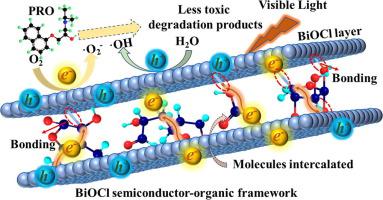Chemical Engineering Journal ( IF 13.3 ) Pub Date : 2021-05-11 , DOI: 10.1016/j.cej.2021.130222 Runren Jiang , Guanghua Lu , Ranran Zhou , Tianjian Dang , Min Wang

|
在这项工作中,通过使用不同类型的碳酸盐饮料(CBs)作为合成溶剂,研究了不同类型的分子插入对BiOCl半导体-有机骨架的形态,光电化学性能,比表面积和光催化降解普萘洛尔(PRO)的影响。在室温下。层间有机分子作为电荷传输电路可以增加BiOCl层状结构的电场强度,并增强层之间的电子耦合。反过来,这引起了窄的带隙能量并抑制了载流子复合。CB中的糖(包括果糖和葡萄糖)分子有助于插入BiOCl层以使其厚度更薄,从而提高BiOCl的比表面积和光吸收能力。另外,CB中的焦糖分子可以帮助加宽光吸收并加速CB-BiOCl的电荷转移能力。CB-BiOCl系统中各种分子的相互作用显着增强了PRO的光催化降解性能。值得注意的是,已鉴定出十二种可能的降解中间体,其毒性随着降解途径而降低。更重要的是,在降解过程中降解溶液对斑马鱼游动活性的抑制作用减弱,表明降解溶液的毒性逐渐减弱。此外,提出了以BiOCl半导体-有机骨架的电荷传输电路为分子的光催化降解PRO的机理。CB中的焦糖分子可以帮助拓宽光的吸收并加快CB-BiOCl的电荷转移能力。CB-BiOCl系统中各种分子的相互作用显着增强了PRO的光催化降解性能。值得注意的是,已鉴定出十二种可能的降解中间体,其毒性随着降解途径而降低。更重要的是,在降解过程中降解溶液对斑马鱼游动活性的抑制作用减弱,表明降解溶液的毒性逐渐减弱。此外,提出了以BiOCl半导体-有机骨架的电荷传输电路为分子的光催化降解PRO的机理。CB中的焦糖分子可以帮助拓宽光的吸收并加快CB-BiOCl的电荷转移能力。CB-BiOCl系统中各种分子的相互作用显着增强了PRO的光催化降解性能。值得注意的是,已鉴定出十二种可能的降解中间体,其毒性随着降解途径而降低。更重要的是,在降解过程中降解溶液对斑马鱼游动活性的抑制作用减弱,表明降解溶液的毒性逐渐减弱。此外,提出了以BiOCl半导体-有机骨架的电荷传输电路为分子的光催化降解PRO的机理。CB-BiOCl系统中各种分子的相互作用显着增强了PRO的光催化降解性能。值得注意的是,已鉴定出十二种可能的降解中间体,其毒性随着降解途径而降低。更重要的是,在降解过程中降解溶液对斑马鱼游动活性的抑制作用减弱,表明降解溶液的毒性逐渐减弱。此外,提出了以BiOCl半导体-有机骨架的电荷传输电路为分子的光催化降解PRO的机理。CB-BiOCl系统中各种分子的相互作用显着增强了PRO的光催化降解性能。值得注意的是,已鉴定出十二种可能的降解中间体,其毒性随着降解途径而降低。更重要的是,在降解过程中降解溶液对斑马鱼游动活性的抑制作用减弱,表明降解溶液的毒性逐渐减弱。此外,提出了以BiOCl半导体-有机骨架的电荷传输电路为分子的光催化降解PRO的机理。它们的毒性随着降解途径而降低。更重要的是,降解溶液对斑马鱼游动活性的抑制作用在降解过程中减弱,表明降解溶液的毒性逐渐减弱。此外,提出了以BiOCl半导体-有机骨架的电荷传输电路为分子的光催化降解PRO的机理。它们的毒性随着降解途径而降低。更重要的是,在降解过程中降解溶液对斑马鱼游动活性的抑制作用减弱,表明降解溶液的毒性逐渐减弱。此外,提出了以BiOCl半导体-有机骨架的电荷传输电路为分子的光催化降解PRO的机理。

"点击查看英文标题和摘要"





















































 京公网安备 11010802027423号
京公网安备 11010802027423号